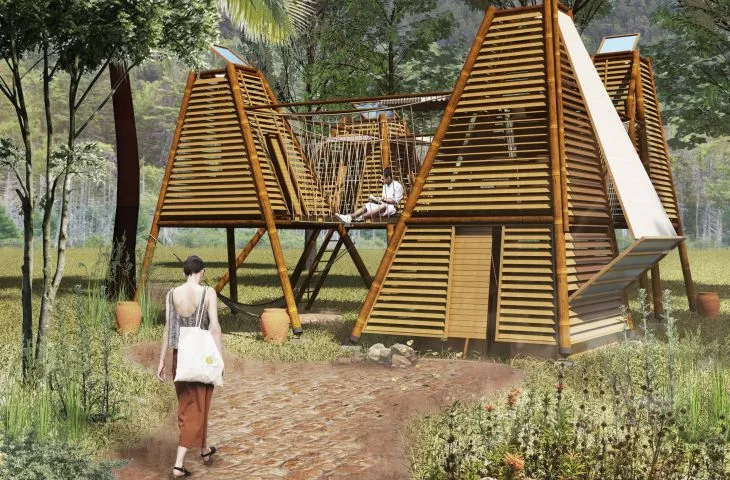Ecotourism is an increasingly popular trend focused on conscious travel, environmental protection and supporting the economy and local culture. Following this trend {tag:studenci}, a student at Wroclaw University of Technology has created a project for self-sustainable tourist huts in Cambodia, built according to sustainable architecture principles.
Modern tourism accounts for more than a tenth of the global economy. Unfortunately, it is associated with a large, often negative impact on the environment. Fortunately, a trend called ecotourism has emerged in recent years in response to commercial tourism. It is geared toward conscious travel that protects the environment and supports and builds on a country's economic and cultural potential. Following this trend, the design, construction and operation of buildings also seeks to minimize the carbon footprint, and environmental impact.
The establishment also includes a spa building
© Justyna Dmytryk
Hideout in Cambodia
Hideout, a project of self-sustainable huts in Cambodia by Justyna Dmytryk, is in line with this trend and seeks to meet the demands that the environment places on us today. Proposed by a student of the Wrocław University of Technology, the hideaway submerged in greenery is meant to be a place where one can disconnect from the outside world and a large amount of stimuli. It is a place that can be explored by moving around it thanks to a specially designed suspended path. The work was inspired by the "Cambodia Remote Hideout Huts" competition task of the Bee Breeders platform and was the subject of an engineering thesis done under the direction of Dr. Krzysztof Cebrat, Prof. of PWr.
The author decided to separate the functions and place them in separate modules
© Justyna Dmytryk
The student began her exploration of the form from the zoning stage. Due to the small area of each hut, the author decided to separate the functions and place them in separate modules, connected by bridges. This solution allows for easy transformability and allows for any configuration of individual units - modules can be combined into larger structures and can be rotated. This makes the design versatile and can be placed in any part of Cambodia.
bamboo modules
The main structure of the modules consists of bamboo poles connected to stiffening beams at the floor and at the finial. The shape of the modules tapers upward for better air draft. The first floor has been elevated to prevent waterlogging of the rooms during the rainy season and provides more privacy. Each unit is equipped with additional elements visible on the elevations, such as the perovskite installation on the south wall of the kitchen, or the protruding rainwater collection structure in the bathroom module. This introduces diversity and emphasizes the variability of the modules due to their purpose.
The designed buildings are self-sufficient
© Justyna Dmytryk
The design of the huts I presented proves that architecture in rural Cambodia can take a variety of forms while avoiding large construction costs, the author adds.
spa, observation tower and footbridge
The project is formed by three additional elements that complement the development of the plot - a spa, a footbridge and a viewing tower. The spa is formed by four modules, with the same form as the residential houses, and each unit is connected by a bridge to the open, covered space of the relaxation terrace, which is a common space.
All structures are connected by a footbridge
© Justyna Dmytryk
In order to organize the plot and introduce new compositional axes, the author designed a simple footbridge, elevated above the ground level. It connects the chalets, the spa center and the viewing tower, forming a dominant feature. Thanks to the designed spacious terraces placed at different heights, the surrounding nature can be observed from the tower.
Justyna Dymytyryk, together with Maja Klawitter, also designed a sustainable housing development in Saint-Denis, which took part in the Multi Comfort Student Contest.





















































